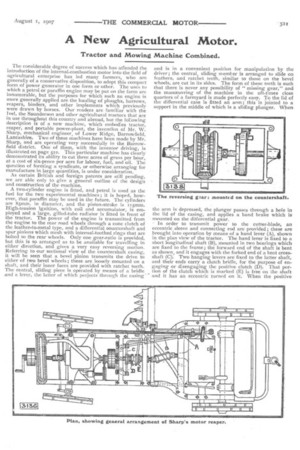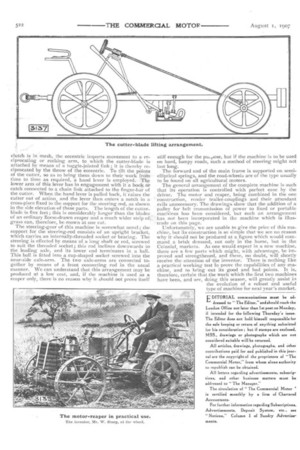A New Agricultural Motor.
Page 5

Page 6

If you've noticed an error in this article please click here to report it so we can fix it.
Tractor and Mowing Machine Combined.
The considerable degree of success which has at-tended the introduction of the internal-combustion motor into the field of agricultural enterprise has led many farmers, who are generally of a conservative disposition, to adopt this compact form of power generator in one form or other. The uses to which a petrol or paraffin engine may be put on the farm are innumerable, but the purposes for which such an engine is more generally applied are the hauling of ploughs, harrows, reapers, binders, and other implements which previously were drawn by horses. Our readers are familiar with the Net, the Saunderson and other agricultural tractors that are in use throughout this country and abroad, but the followingdescription is of a new machine, which embodies tractor, reaper, and portable power-plant, the inventibn of Mr. W. Sharp, mechanical engineer, of Lower Ridge, Barrowfield, Lancashire. Two of these machines have been made by Mr. Sharp, and are operating very successfully in the Barrowfield district. One of them, with the inventor driving, is illustrated on page 522. This particular machine has clearly demonstrated its ability to cut three acres of grass per hour, at a cost of six-pence per acre for labour, fuel, and oil. The question of forming a syndicate, or otherwise arranging for manufacture in large quantities, is under consideration.
As certain British and foreign patents are still pending, we are able only to give a general outline of the design and construction of the machine.
A two-cylinder engine is fitted, and petrol is used as the fuel for the two experimental machines ; it is hoped, however, that paraffin may be used in the future. The cylinders are 85mm. in diameter, and the piston-stroke is II5MM. High-tension ignition, with coil and accumulator, is employed and a large, gilled-tube radiator is fitted in front of the tractor. The power of the engine is transmitted from the engine to the rear road wheels through a cone clutch of the leather-to-metal type, and a differential countershaft and spur pinions which mesh with internal-toothed rings that are bolted to the rear wheels. Only one gear-ratio is provided, but this is so arranged as to be available for travelling in either direction, and gives a very easy reversing motion. Referring to our sectional view of the countershaft casing, it will be seen that a bevel pinion transmits the drive to either of two bevel wheels ; these are loosely mounted on a shaft, and their inner faces are provided with ratchet teeth. The central, sliding piece is operated by means of a bridle, and a lever, the latter of which projects through the casing
and is in a convenient position for manipulation by the driver ; the central, sliding memlcer is arranged to slide on feathers, and ratchet teeth, similar to those on the bevel wheels, are cut in its sides. The form of these teeth is such that there is never any possibility of " missing gear," and the manceuvring of the machine in the oft-times close quarters of a farmyard is made perfectly easy. To the lid of the differential case is fitted an arm ; this is jointed to a support in the middle of which is a sliding plunger. When the arm is depressed, the plunger passes through a hole in the lid of the casing, and applies a band brake which is mounted on the differential gear.
In order to transmit power to the cutter-blade, an eccentric sleeve and connecting rod are provided ; these are brought into operation by means of a hand lever (A), shown in the plan view of the tractor. The hand lever is fixed to a short longitudinal shaft (B), mounted in two bearings which are fixed to the frame; the forward end of the shaft is bent as shown, and it engages with the forked end of a bent crossshaft (C). Two hanging levers are fixed to the latter shaft, and their ends carry a clutch bridle, for the purpose of engaging or disengaging the positive clutch (D). That portion of the clutch which is marked (E) is free on the shaft " and it has an eccentric turned on it. When the positive
clutch is in -mesh, the eccentric imparts movement to a reciprocating or rocking arm, to which the cutter-blade is attached by means of a toggle-jointed link ; it is thereby reciprocated by the throw of the eccentric. To tilt the points of the cutler, so as to bring them down to their work frorn time to time as required, .a hand lever -is employed. The lower arm of this lever has in engagement With it a hook. or catch connected to a chain link attached to the finger-bar of the cutter. When the hand lever is pulled hack, it raises the cutter out of action, and the lever then enters a notch in a cross-piece fixed to the support for the steering rod, as shown in the side elevation of these parts. The length of the cutter bladeis five feet ; this is considerably longer than the blades of an ordinary liorse-drawn reaper and a much wider strip of.; grass can, therefore, be mown at one cut.
The steering-gear of this machine is somewhat novel ; the support for the steering-rod consists of an upright bracket, which carries an internally-threaded socket or bearing. The steering is effected by means of a long shaft or rod, screwed to suit the threaded socket ; this rod inclines downwards to the leading axle, and its lower end terminates in a bail. This ball is fitted into a cup-shaped socket screwed into the near-side axle-arm. The two axle-arms are connected together by means of a front connecting rod in the usual manner. We can understand that this arrangement may be produced at a low cost, and, if the machine is used as a reaper only, there is no reason why it should not prove itself
stiff enough for the pwliose, but if the machine is to be used on hard, lumpy roads, such a method of steering might not Last long.
The forward end of the main frame is supported on semielliptical springs, and the road-wheels are of the type usually to be found on all agricultural motors. The general arrangement of the complete machine is such that its operation is controlled with perfect ease by the driver. The motor and reaper, being combined in the one construction, render trailer-couplings and their attendant evils unnecessary. The drawings show that the addition of a 'pulley for belt transmission of power to fixed or portable machines has been considered, but such an arrangement has not been incorporated in the machine which is illustrade on this page. Unfortunately, we are unable to give the price of this machine, but its construction is so simple that we see no reason why it should not be produced at a figure which would coin.. rnand a brisk demand, not only in the home, but in the Colonial, markets. As one would expect in a new machine, there are a few parts which might, with advantage, be improved and strengthened, and these, no doubt, will shortly receive the attention of the inventor. There is nothing like a practical working test lo prove the capabilities of any machine, and to bring out its good and bad points. It is, therefore, certain that the work which the first two machines have been, and are, doing this season, will greatly assist in the evolution of a robust and useful type of machine for next year's market.


























